Arundel Castle, a magnificent edifice steeped in centuries of history, stands as a testament to architectural brilliance and cultural significance. Its imposing silhouette against the Sussex landscape beckons visitors to embark on a journey through time, where grandeur, intrigue, and natural beauty intertwine.
From its medieval origins to its modern-day splendor, Arundel Castle has witnessed countless events that have shaped the course of English history. Within its hallowed halls, monarchs have resided, momentous gatherings have unfolded, and artistic masterpieces have been inspired.
History and Architecture
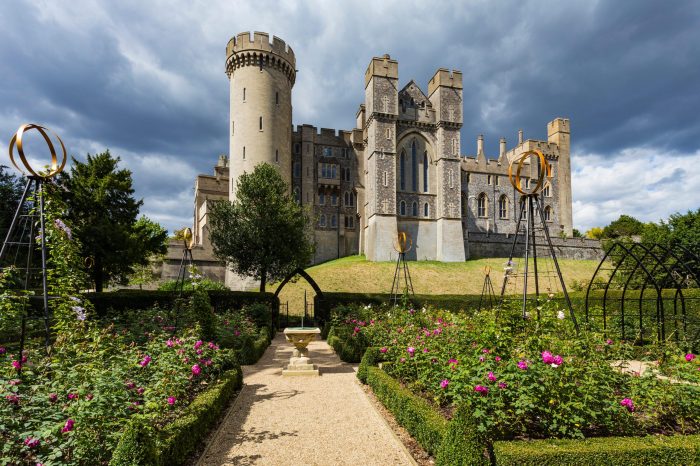
Arundel Castle, a majestic fortress in West Sussex, England, boasts a rich history spanning centuries. Its origins can be traced back to the 11th century, when it was constructed by Roger de Montgomery, Earl of Arundel, following the Norman conquest of England.
Over the centuries, Arundel Castle has undergone significant architectural transformations. In the 12th century, a stone keep was added, providing a formidable defense against attackers. During the 14th century, the castle was extensively remodeled in the Gothic style, with the addition of towers, battlements, and a great hall. These renovations transformed Arundel Castle into a luxurious residence, fit for the powerful Fitzalan family, who held the title of Earl of Arundel.
Unique Architectural Features, Arundel castle
Arundel Castle is renowned for its unique architectural features, blending elements of different historical periods. The castle’s imposing curtain wall, punctuated by 14 towers, provides a glimpse into its medieval origins. The magnificent Gothic great hall, with its soaring vaulted ceiling and intricate stained-glass windows, showcases the architectural grandeur of the 14th century.
The castle’s 17th-century state apartments, known as the Long Gallery and the Painted Parlour, are adorned with exquisite Baroque plasterwork and painted ceilings. These rooms offer a glimpse into the opulent lifestyle of the Howard family, who acquired Arundel Castle in the 16th century.
Timeline of Significant Events and Renovations
- 1067: Roger de Montgomery, Earl of Arundel, constructs a wooden castle on the site.
- 1102: The stone keep is added to the castle.
- 13th century: The castle is expanded and fortified by the Fitzalan family.
- 14th century: Major renovations in the Gothic style, including the great hall and towers.
- 16th century: The Howard family acquires Arundel Castle.
- 17th century: Construction of the state apartments and Baroque renovations.
- 19th century: Extensive restoration and remodeling by the Duke of Norfolk.
Notable Residents and Events
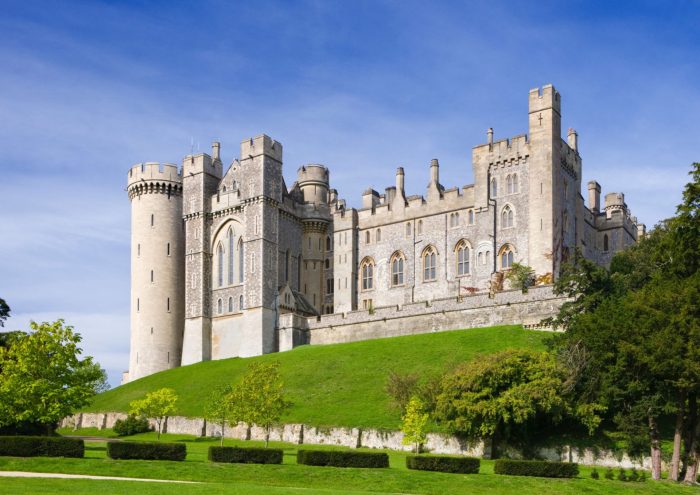
Arundel Castle has welcomed numerous notable residents and witnessed significant events throughout its rich history. From medieval monarchs to modern-day aristocrats, the castle has played host to a diverse cast of characters.
Royal Residents
Over the centuries, Arundel Castle has been home to several English monarchs, including King Henry II, who granted the castle to his son, William de Albini, in the 12th century. King Richard II also resided in the castle during the 14th century, using it as a royal hunting lodge.
Aristocratic Families
Arundel Castle has also been the seat of several prominent aristocratic families, including the Earls of Arundel and the Dukes of Norfolk. The Howard family, who acquired the castle in the 16th century, played a significant role in English history and continues to reside in the castle today.
Historical Events
The castle has also been the site of numerous historical events. In 1397, King Richard II was arrested at Arundel Castle by Henry Bolingbroke, who later became King Henry IV. During the English Civil War in the 17th century, the castle was besieged by Parliamentarian forces and eventually surrendered.
Social Gatherings
Arundel Castle has also hosted many social gatherings and events. In the 19th century, the castle was a popular destination for grand balls and receptions, attended by members of the British aristocracy and high society. Today, the castle continues to host a variety of events, including weddings, conferences, and cultural exhibitions.
Gardens and Grounds
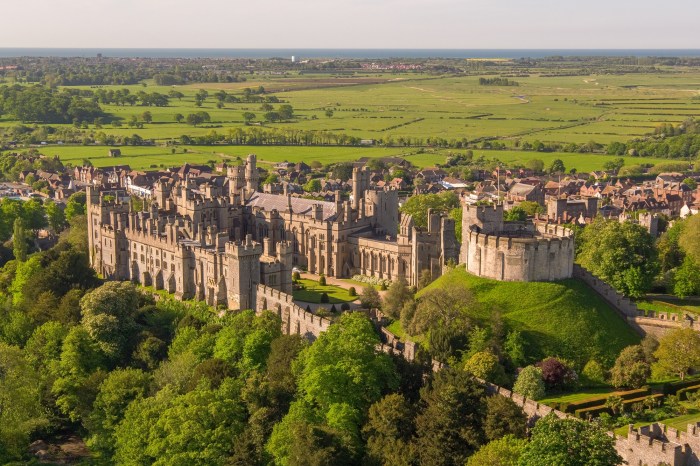
The gardens and grounds of Arundel Castle are a testament to the castle’s rich history and enduring beauty. Spanning over 40 acres, the gardens offer a diverse array of horticultural delights, from formal terraces to picturesque woodlands.
The gardens were first laid out in the 16th century and have been continuously developed over the centuries. The current design is largely the work of the 19th-century landscape architect, William Andrews Nesfield, who created a series of interconnected gardens that flow seamlessly into the surrounding landscape.
Formal Gardens
The formal gardens are located on the south side of the castle and are characterized by their geometric layout and clipped hedges. The gardens are divided into a series of terraces, each with its own unique design. The Upper Terrace features a parterre of colorful flower beds, while the Middle Terrace is home to a rose garden and a fountain. The Lower Terrace offers stunning views of the River Arun and the South Downs.
Woodland Gardens
The woodland gardens are located on the north side of the castle and offer a more natural setting. The gardens are home to a variety of trees and shrubs, including oaks, beeches, and rhododendrons. The woodland gardens are also home to a number of streams and ponds, which provide a habitat for a variety of wildlife.
Horticultural Significance
The gardens and grounds of Arundel Castle are home to a number of important plant collections. The rose garden is home to over 2,000 roses, including many rare and unusual varieties. The woodland gardens are home to a number of champion trees, including the tallest oak tree in England.
Aesthetic and Recreational Value
The gardens and grounds of Arundel Castle are not only a horticultural delight, but they also play an important role in the overall aesthetic and recreational value of the castle. The gardens provide a beautiful setting for the castle and offer visitors a place to relax and enjoy the outdoors. The gardens are also used for a variety of events, including weddings, concerts, and exhibitions.
Cultural and Artistic Significance
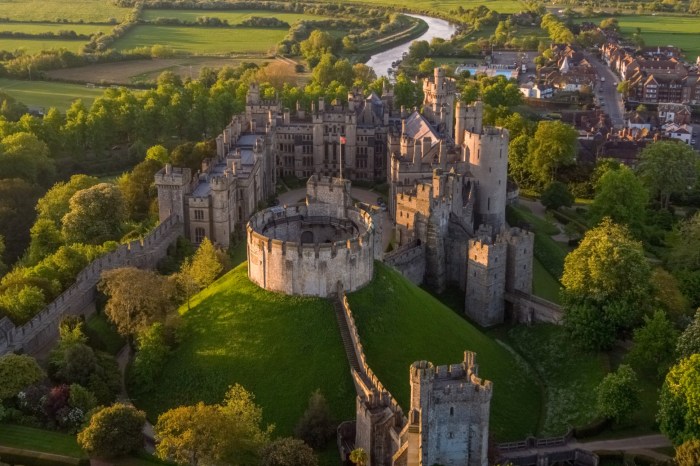
Arundel Castle’s architectural grandeur and historical significance have made it a prominent cultural landmark and a source of inspiration for artists, writers, and filmmakers.
In literature, Arundel Castle has been featured in works by notable authors such as William Shakespeare, who referenced it in his play “Richard II,” and Jane Austen, who mentioned it in her novel “Pride and Prejudice.” The castle’s imposing presence and rich history have captivated the imaginations of writers, who have used it as a setting for historical dramas and romantic tales.
Art
Arundel Castle has also been a subject of artistic depictions. Its striking architecture and picturesque surroundings have attracted painters, photographers, and sculptors. The castle has been immortalized in paintings by renowned artists such as J.M.W. Turner and John Constable, who captured its grandeur and the surrounding landscape in their works.
Film
In recent years, Arundel Castle has gained recognition as a filming location for movies and television shows. Its medieval ambiance and well-preserved interiors have provided an authentic backdrop for historical dramas and fantasy productions. Notable productions that have featured the castle include the BBC series “The Hollow Crown” and the film “Robin Hood” (2010).
Arundel Castle, a magnificent medieval fortress nestled in West Sussex, boasts a rich history spanning centuries. Its grandeur rivals that of the famed accademia gallery in Florence, Italy, showcasing masterpieces by Michelangelo and other Renaissance giants. Yet, amidst the castle’s splendor, the echoes of its storied past linger, reminding visitors of its role as a seat of power and a witness to the ebb and flow of time.
Cultural Landmark
As a cultural landmark, Arundel Castle plays a vital role in preserving and showcasing the rich historical heritage of England. Its ongoing restoration and preservation efforts ensure that future generations can appreciate its architectural splendor and learn about its historical significance. The castle’s status as a popular tourist destination also contributes to its cultural importance, as it provides a tangible connection to the past and fosters an appreciation for history and heritage.
Arundel Castle, an iconic English fortress with a rich history, stands as a testament to the passage of time. While its walls have witnessed countless moments, from medieval battles to royal visits, the castle’s clock tower keeps pace with the ever-changing present.
For those curious about the time in far-off lands, a quick glance at the abu dhabi time will reveal the hours in the United Arab Emirates, a reminder that Arundel Castle’s legacy extends beyond its own walls, connecting it to the wider world.
Visitor Experience
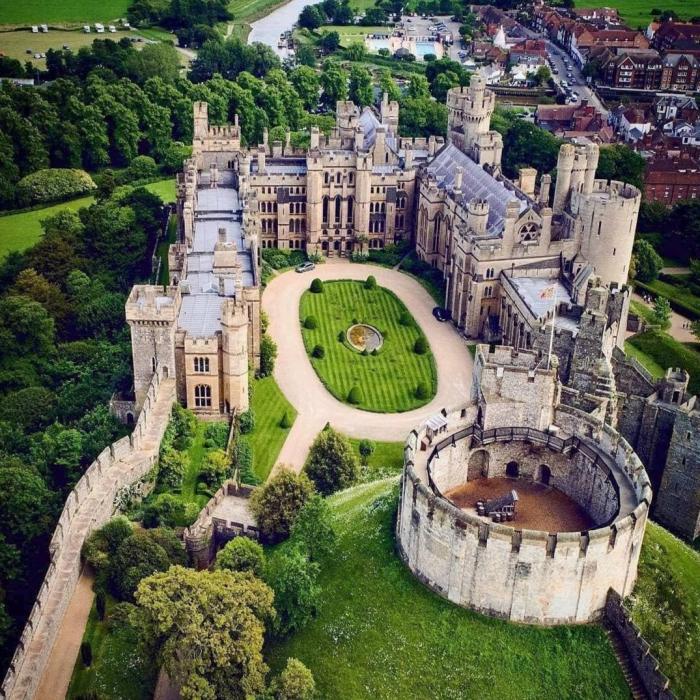
Arundel Castle offers a captivating and comprehensive visitor experience, with an array of attractions and amenities designed to cater to diverse interests.
Admission fees vary depending on the type of visit, whether it includes guided tours, and the age of the visitor. Guided tours provide an in-depth exploration of the castle’s rich history, architecture, and notable residents.
Nestled amidst the verdant Sussex countryside, Arundel Castle boasts a rich history dating back to the 11th century. Its towering keep offers panoramic views of the surrounding landscape. While in the area, nature enthusiasts may wish to venture to Akaka Falls State Park in Hawaii, renowned for its breathtaking waterfalls and lush rainforest trails.
Upon returning to Arundel Castle, visitors can delve into its fascinating past through guided tours and explore its captivating gardens.
Admission Fees
| Ticket Type | Price |
|---|---|
| Adult | £16.50 |
| Child (5-15) | £9.90 |
| Family (2 adults + 2 children) | £42.00 |
| Guided Tour (additional) | £5.00 |
Guided Tours
Guided tours are highly recommended for a comprehensive understanding of Arundel Castle’s history and significance. Tours are led by knowledgeable and engaging guides who provide fascinating insights into the castle’s past and present.
Amenities
- Gift Shop: Offers a wide range of souvenirs, including books, postcards, and gifts.
- Tea Room: Serves light refreshments and snacks.
- Picnic Area: Designated areas within the castle grounds for visitors to enjoy picnics.
- Parking: Ample parking is available for visitors.
- Disabled Access: The castle is wheelchair accessible, with ramps and lifts available.
Areas and Attractions
Arundel Castle encompasses various areas and attractions, each offering a unique experience:
- Keep: The oldest part of the castle, offering panoramic views of the surrounding countryside.
- State Rooms: A suite of grand rooms used for entertaining guests and displaying the family’s art collection.
- Chapel: A beautiful Gothic chapel used for weddings and other special events.
- Gardens: Extensive gardens surrounding the castle, featuring formal gardens, rose gardens, and a woodland walk.
Sustainability and Conservation
Arundel Castle has been meticulously preserved and maintained over the centuries to ensure its historical integrity. The castle is regularly inspected and undergoes restoration work as needed, using traditional materials and techniques to maintain its authenticity. The castle’s interiors have also been carefully restored to reflect their original grandeur, with many of the rooms featuring original furnishings and artwork.
In addition to preserving the castle’s physical structure, the Arundel Castle Trust is committed to sustainable practices in the management of the castle and its surroundings. The castle uses renewable energy sources, such as solar and geothermal energy, to reduce its carbon footprint. The castle’s gardens are maintained using organic practices, and the castle’s water supply is managed efficiently to conserve water.
Balancing conservation with accessibility can be a challenge, but the Arundel Castle Trust has taken steps to ensure that the castle is accessible to visitors while still preserving its historical integrity. The castle’s grounds are open to the public, and there are a variety of accessible tours available for visitors with disabilities. The castle’s interiors are also accessible, with ramps and lifts installed to allow visitors to access all areas of the castle.
Challenges and Opportunities
One of the challenges in balancing conservation with accessibility is the need to make changes to the castle’s structure to accommodate visitors with disabilities. These changes must be made carefully to ensure that they do not damage the castle’s historical integrity. Another challenge is the need to maintain the castle’s authenticity while still making it comfortable for visitors. For example, the castle’s windows are not double-glazed, which can make the castle cold in the winter. However, double-glazing the windows would alter the castle’s appearance and damage its historical integrity.
Despite these challenges, there are also opportunities to balance conservation with accessibility. For example, the Arundel Castle Trust has installed a lift in the castle’s keep, which allows visitors with disabilities to access the castle’s highest point. The Trust has also installed ramps and widened doorways to make the castle more accessible for visitors with mobility impairments.
The Arundel Castle Trust is committed to continuing to find ways to balance conservation with accessibility, so that everyone can enjoy this historic castle.
Epilogue: Arundel Castle

Arundel Castle remains an enduring symbol of England’s rich heritage, a living testament to the human spirit’s ability to create enduring works of art and architecture. Its gardens, steeped in horticultural significance, complement the castle’s grandeur, creating a harmonious blend of nature and history.
Today, Arundel Castle welcomes visitors from far and wide, offering a glimpse into its storied past and captivating present. Whether exploring its ancient dungeons, marveling at its exquisite art collection, or simply strolling through its picturesque grounds, the castle promises an unforgettable experience that will linger long after your visit.
Question Bank
When was Arundel Castle built?
The castle’s origins date back to the 11th century, with significant additions and renovations made throughout its history.
Who has resided in Arundel Castle?
Arundel Castle has been home to numerous notable figures, including King Henry I, Queen Eleanor of Provence, and the Dukes of Norfolk.
What are the highlights of a visit to Arundel Castle?
Visitors can explore the castle’s grand halls, dungeons, and art collection, as well as wander through its beautiful gardens.
Is Arundel Castle open to the public?
Yes, Arundel Castle is open to the public during certain hours and offers guided tours.